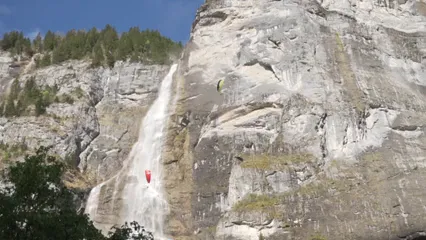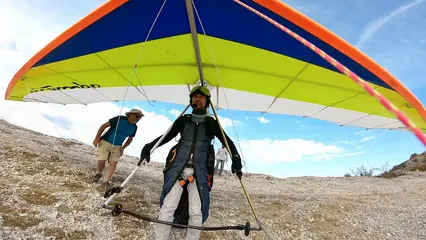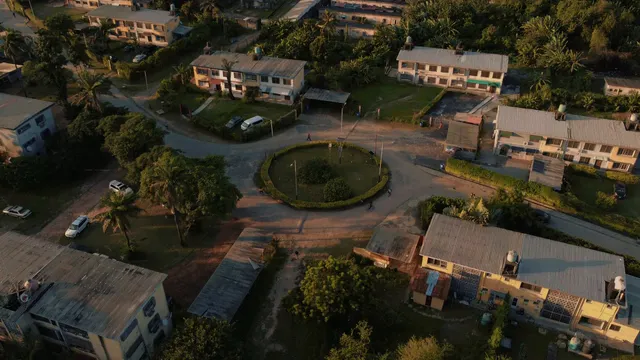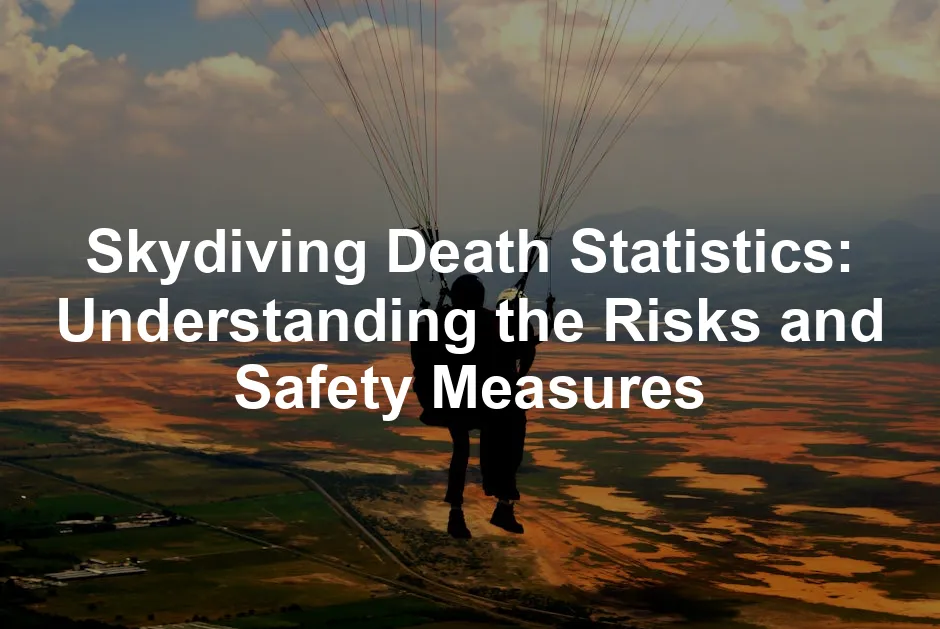Introduction
Skydiving is an exhilarating adventure sport that tempts thrill-seekers to leap from planes, defying gravity and embracing the skies. The rush of free-falling at 120 mph is unmatched, offering a unique perspective on life. It’s no wonder that this extreme sport attracts thousands each year, turning everyday folks into gravity-defying daredevils.
Yet, with every thrill comes a hint of fear. Many potential jumpers grapple with worries about safety, particularly regarding fatalities. After all, it’s not every day you jump out of a “perfectly good” airplane. The reality is that while skydiving does involve risks, advancements in safety measures have significantly reduced the chances of accidents over the years.
This article aims to sift through the statistics surrounding skydiving fatalities. We’ll analyze trends over the years and highlight the remarkable safety improvements made in the industry. By understanding the risks and how they’ve changed, we can better appreciate the safety measures in place today. So, buckle up—it’s time to unravel the numbers behind skydiving death statistics and empower yourself with knowledge before taking the plunge.

Understanding skydiving death statistics can help you appreciate the safety measures in place today. skydiving death statistics
The Evolution of Skydiving Safety
Historical Context of Skydiving Safety
Skydiving has come a long way since its inception. The sport began in the early 20th century, primarily for military purposes. Back then, the gear was rudimentary, and safety was often an afterthought. In the 1960s, fatalities were alarmingly high, averaging 11.12 per 100,000 jumps. However, the skydiving community took notice. Over the decades, significant advancements in equipment and training transformed the sport.
Improvements in parachute technology, such as better materials and designs, have led to safer descents. Today’s parachutes are equipped with smart features, like the Automatic Activation Device (AAD), which deploys the reserve parachute if needed. Training programs have also evolved, incorporating lessons on emergency procedures, landing techniques, and risk management.
For those looking to embrace the thrill of skydiving, a reliable Parachute Backpack is essential. It ensures your gear is organized and easily accessible, allowing you to focus on the fun instead of fumbling around. Plus, nothing says adventure like a well-packed bag for your skydiving escapades!

Current Safety Measures
Modern skydiving systems include both a main and a reserve parachute, ensuring a backup in case the primary chute fails. The AAD plays a crucial role, monitoring altitude and descent rate. If a skydiver is unable to deploy the parachute, the AAD kicks in, deploying the reserve automatically. This safety feature is used by around 90% of experienced jumpers, drastically reducing the risk of fatality due to equipment failure.
Skydiving is now governed by strict regulations set by organizations like the United States Parachute Association (USPA). These regulations ensure that all jumpers receive proper training and that instructors adhere to high safety standards. In 2023, the USPA recorded just 10 fatalities from approximately 3.65 million jumps, showcasing the impact of these safety measures.
If you’re serious about skydiving, consider investing in an Skydiving Helmet. Not only does it protect your noggin during high-speed descents, but it also enhances communication with your instructor and fellow jumpers. Safety never looked so cool!

Skydiving Death Statistics Overview
Recent Trends in Fatalities
Skydiving is thrilling, but it comes with inherent risks. Understanding the statistics surrounding fatalities helps potential jumpers make informed decisions. Let’s break down the data from the United States Parachute Association (USPA) and see the trends that have emerged in recent years.
The USPA reports that between 2021 and 2023, the number of fatalities in skydiving has fluctuated. In 2021, the fatality rate was 0.28 per 100,000 jumps, with 10 fatalities recorded. The following year, it increased to 20 fatalities, leading to a rate of 0.51. However, in a remarkable turn of events, 2023 marked a record low of just 10 fatalities from approximately 3.65 million jumps. This equates to an astonishing fatality rate of 0.27 per 100,000 jumps, despite the heightened activity in the sport. Such a low number highlights the effectiveness of safety protocols and advancements in training and equipment over the years.
To capture those memorable moments, don’t forget to bring along your GoPro HERO10 Black. This action camera captures your free-fall experience in stunning quality, ensuring you can relive the adrenaline rush time and time again. Plus, your friends will be super jealous of your epic footage!

Fatality Rate Comparison
When we compare the current statistics to historical data, the contrast is striking. Back in 1961, the fatality rate was alarmingly high, averaging between 6 and 11.12 fatalities per 100,000 jumps. This would translate to approximately 401 fatalities annually at today’s jump levels! Fast forward to 2023, and we see a significant drop, showcasing the remarkable progress the skydiving community has made. The reduction in fatalities suggests a concerted effort to enhance safety measures, indicating that the sport has become significantly safer for participants.

Fatalities by Demographics
Understanding the demographics of skydiving fatalities provides further insight into the risks involved. Statistics reveal that most fatalities occur among experienced jumpers, particularly those attempting risky maneuvers. In 2023, six out of ten fatalities were attributed to landing problems, especially related to intentional low turns. These incidents often involve jumpers who have thousands of jumps under their belts, demonstrating that experience doesn’t always equate to safety. Interestingly, men are more likely to be involved in fatal incidents compared to women, and the average age of those who succumb to skydiving accidents hovers around 36 years.
In summary, while the thrill of skydiving is undeniably captivating, it’s crucial to recognize the risks. The statistics indicate a positive trend, with efforts towards improved safety leading to fewer fatalities. Understanding these figures equips potential jumpers with knowledge, allowing them to make informed decisions and prioritize safety as they prepare for their skydiving adventure.

Analyzing Causes of Skydiving Fatalities
Human Error vs. Equipment Failure
When it comes to skydiving fatalities, the culprit isn’t usually the parachute. Surprisingly, around 90% of skydiving deaths are attributed to human error. Yes, you read that right! Most accidents occur due to poor judgment rather than equipment malfunction. Imagine this: you’re soaring through the sky, adrenaline pumping, and then you decide to pull off an impressive landing move. Spoiler alert: it doesn’t always end well.
Take, for instance, improper landing techniques. Jumpers attempting risky maneuvers, like low turns, often misjudge their altitude and speed. This can lead to disastrous outcomes. In 2023, six out of ten fatalities stemmed from landing issues, particularly intentional low turns. These daring stunts often lead to collisions with the ground or obstacles, resulting in serious injuries or even death.
Another common human error involves not following established emergency procedures. In a high-pressure situation, a skydiver may panic and forget their training. For instance, one incident involved a jumper with a wingsuit who failed to deploy his parachute correctly after experiencing a spinning malfunction. Sadly, this resulted in a fatality.
In stark contrast, equipment failure accounts for less than 10% of fatalities. Despite rigorous testing and maintenance protocols, equipment malfunctions can happen. However, the advanced technology in modern parachute systems, including Automatic Activation Devices (AADs), significantly mitigates these risks. If a skydiver fails to deploy their main parachute, the AAD can automatically deploy the reserve parachute. This feature is used by about 90% of experienced jumpers, helping to keep them safe and sound.

Categories of Fatalities
To fully grasp the landscape of skydiving fatalities, let’s break down the contributing factors from recent data.
- Landing Problems (60%): As previously mentioned, landing issues are the leading cause of fatalities. Jumpers often push their limits with high-performance landings. For example, one jumper with over 5,000 jumps attempted a dangerous downwind landing and collided with a vehicle, leading to significant injuries. Another case involved a jumper who struck water at over 60 mph after a steep dive.
- Equipment Issues (10%): Although rare, equipment problems do occur. In 2023, a 69-year-old male experienced a malfunction due to a knotted steering line, resulting in a fatal impact. The importance of proper maintenance and checks cannot be overstated.
- Incorrect Emergency Procedures (10%): Following the wrong emergency protocol can be deadly. A seasoned jumper failed to deploy his parachute correctly during a spinning malfunction, leading to tragic consequences. This highlights how critical it is to stay calm and follow training during emergencies.
- Medical Emergencies (10%): Occasionally, medical emergencies can strike unexpectedly. A 44-year-old female experienced a medical issue during her second skydive, resulting in her death. Medical conditions can play a significant role in fatalities, underscoring the need for jumpers to be aware of their health status.
In summary, while skydiving is thrilling, understanding the causes of fatalities can help jumpers make informed decisions. The majority of deaths result from human error rather than equipment failure, emphasizing the importance of proper training and adherence to safety protocols. By recognizing these factors, skydivers can enhance their skills, reduce risks, and enjoy the exhilarating experience of free-fall with greater confidence.
If you’re preparing for a jump, don’t forget to pack an Emergency Medical Kit. It’s better to be safe than sorry, and having one on hand could make all the difference in case of an unexpected situation!

Risk Assessment: How Safe Is Skydiving?
Comparative Risk Analysis
Skydiving often gets a bad rap for being dangerous. But let’s put things in perspective. The odds of dying while skydiving are about 1 in 100,000 jumps. That’s like being more likely to be struck by lightning while simultaneously winning the lottery! In fact, the risk of dying in a car crash is a staggering 1 in 5,000. Yes, you read that right. Would you stop driving because of that? Probably not!
Now, let’s talk about those beloved everyday activities. The risk of choking is estimated at 1 in 2,659, and the odds of being bitten by a dog? A whopping 1 in 53,843. So, why do we fear skydiving more than, say, crossing the street? Perhaps it’s the dramatic visuals of someone jumping out of a perfectly good airplane. But the stats tell a different story, one filled with excitement and surprisingly low fatality rates.
Public perception often skews toward fear. Media headlines don’t help, either. They love a good skydiving accident story. Yet, when you compare the statistics, skydiving is safer than many daily activities. So next time someone gasps at the thought of you jumping from the sky, remind them about the real risks lurking in their own lives.
For those planning a skydiving trip, consider bringing a Outdoor First Aid Manual. This handy guide can equip you with knowledge on how to handle various situations, ensuring you’re prepared for anything that may come your way!

Safety Culture in the Skydiving Community
The skydiving community is a close-knit bunch, filled with safety enthusiasts. Safety training is paramount. New jumpers are mentored by seasoned professionals, ensuring they learn the ropes before free-falling through the skies. Many drop zones host Safety Day events, where jumpers gather to refresh their skills, share knowledge, and reinforce safety protocols. It’s like a safety pep rally, but with parachutes!
Moreover, the community emphasizes accountability. Jumpers are encouraged to speak up if they see someone engaging in risky behavior. This culture fosters an environment where everyone looks out for each other. It’s not just about the thrill; it’s about ensuring that everyone can continue to enjoy the sport safely.
With organizations like the United States Parachute Association (USPA) providing oversight, the sport continuously improves its safety measures. The USPA conducts thorough investigations into accidents to learn from them. Their commitment to safety means that jumper education is constantly evolving to adapt to new challenges.
If you’re looking to document your skydiving experiences, a Skydiving Logbook is a must-have. It helps you keep track of your jumps, making it easier to reflect on your progress and experiences over time. Plus, it’s a great conversation starter!

Conclusion
Skydiving is a thrilling activity that many people dream of experiencing. With its rapid growth in popularity, understanding the associated risks is crucial. Throughout this article, we have explored the death statistics related to skydiving, revealing important insights into safety and trends.
The statistics show a significant decline in fatalities over the years. For instance, in 2023, skydiving recorded just 10 fatalities from approximately 3.65 million jumps. This represents a remarkable fatality rate of 0.27 per 100,000 jumps, the lowest on record. Such numbers reflect the skydiving community’s commitment to safety and the continuous improvements made in equipment and training.
While skydiving carries inherent risks, proper training and adherence to safety protocols can effectively mitigate these dangers. The data highlights that most fatalities stem from human error rather than equipment failure. Thus, education and disciplined execution of safety measures are paramount for both new and experienced jumpers.
For potential jumpers, it’s essential to make informed decisions based on reliable data. Understanding the statistics allows you to grasp the real risks involved. This knowledge empowers you to prioritize safety while enjoying the exhilarating experience of free-falling.
So, if you’re considering taking the plunge, remember: the thrill of skydiving can be enjoyed with a solid understanding of safety measures in place. Don’t let fear hold you back; embrace the adventure with confidence!

FAQs
What is the fatality rate of skydiving?
The fatality rate for skydiving has significantly improved over the years. In 2023, the United States Parachute Association (USPA) reported a fatality rate of 0.27 per 100,000 jumps, with only 10 fatalities recorded. This is a stark contrast to the 1961 rate, which ranged from 6 to 11.12 fatalities per 100,000 jumps. The evolution of safety protocols and gear has played a crucial role in this decline.
Are tandem skydives safer than solo skydives?
Yes, tandem skydive fatalities are lower compared to solo jumps. The structured nature of tandem skydiving, where a novice is paired with an experienced instructor, allows for a higher level of safety. The fatality rate for tandem jumps is reported to be approximately 0.11 per 100,000 jumps, making it a safer option for first-time jumpers.
What should first-time jumpers know about safety?
First-time jumpers should prioritize safety by choosing a reputable drop zone and following all pre-jump instructions. It’s essential to listen closely during training, ask questions, and maintain a calm mindset. Additionally, understanding the importance of equipment checks and emergency procedures can enhance your safety during the jump.
How often do skydiving fatalities occur?
Skydiving fatalities are rare, averaging about 10 deaths per year in recent times. This statistic translates to a fatality rate of approximately 0.27 per 100,000 jumps in 2023. Despite the increasing number of jumps, the consistent decline in fatalities indicates that the sport is becoming safer.
Additional Resources
For more information on skydiving safety and best practices, consider visiting the following websites:
These resources provide valuable insights and guidelines to ensure safe and enjoyable skydiving experiences. Happy jumping!
And while you’re at it, don’t forget to pack some Adventure Snacks Variety Pack for energy on your journey! You never know when you might need a quick boost.
Please let us know what you think about our content by leaving a comment down below!
Thank you for reading till here 🙂
All images from Pexels




